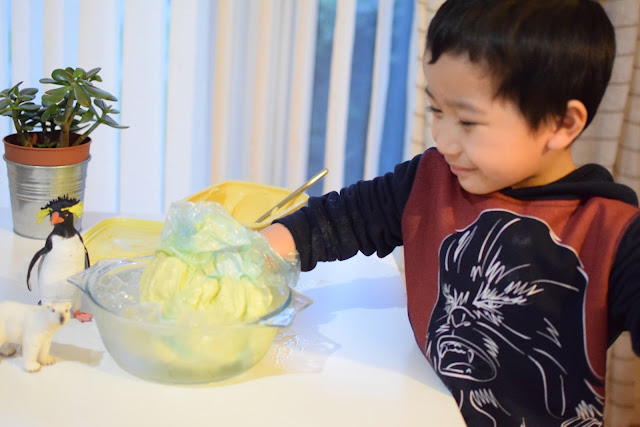We’ve been learning about polar animals for the past week, and Mavi and Vito have the same question that kept popping up during the course of our learning: why are these animals like the polar bears and penguin don’t get cold in the ice? Well, to answer the question we did a simple experiment on what makes these animals warm in the polar regions.
Objective:
The experiment aims to determine how blubber insulates or keeps the animals warm in the polar regions.
Materials Needed:
1. butter or shortening
2. plastic wrap, Ziploc
3. ice cubes
4. bowl or water
5. timer

What to do?

In a large bowl, prepare a mix of ice and water. Make sure that there’s plenty of ice in the water to make it really cold.
To prepare the animals’ undercoat, cover one hand with a plastic. Place a large amount of butter in the wrapped plastic hand, this way, the hand doesn’t get into the butter. I bought 1 kg of butter for the boys and these were enough to cover their hands. Sealed the butter with another plastic wrap or Ziploc.
Dip the hand with the butter in the bowl of ice/water and start your timer. Record the time on how long the hand can withstand the cold.
Next, dip the child’s other hand (bare hand) in the ice cold water and record the time on how long the hand can withstand the cold.

What Happened?
Both of the boys did this activity and with a timer, we compared the results.
BARE HAND (NO blubber):
- Mavi: 9 sec
- Vito: 25 sec
HAND WITH BUTTER (blubber):
- Mavi: 3 mins 2 sec
- Vito: 5 mins 11 sec
Why?
The plastic bag represents the skin of some animals in the polar regions like penguins, polar bears and seals. The butter represents the layer of the blubber beneath that skin and the hand represents the animals’ inner body.
While these animals have feathers and skin, they need extra insulation from the frigid cold environment in the polar regions. This extra protection is provided by a thick layer of fat called blubber, which is located under the animals’ skin. The blubber limits the movement of heat away from the warm inner body of the animals to the freezing air or icy ground outside its body.
In the experiment, the hand feels cold when “heat” is removed from your body by the ice cube. The butter insulated the hand from the ice cold water, so the hand with butter on it lost less heat and felt warmer.
Follow us on Facebook, Pinterest, Google Plus, Instagram or Twitter for updates!
More learning materials at Pinay Homeschooler Shop. For FREE learning materials check out our FREE Downloads and FREE Learning Materials page.
Pin this for later!
This post is part of the 12 Months Montessori Series which is hosted by Natural Beach Living and The Natural Homeschool.
Yarn Paper Plate Heart Craft - Beginner Sewing for Preschool and Kindergarten | Natural Beach Living
Montessori-Friendly Ways to Teach Kids about Animals in Winter ~ Printables Included | The Natural Homeschool
Hundreds of Montessori-Friendly Resources for Chinese New Year (Lunar New Year) | Living Montessori Now
Montessori Arctic Activities and Printables | Mama’s Happy Hive
Montessori Self-Care Essentials for Winter | The Kavanaugh Report
How Polar Animals Keep Warm Experiment | The Pinay Homeschooler
How To Make A Felt Penguin Life Cycle Every Kid Will Love | Uno Zwei Tutu




0 comments:
Post a Comment
Thanks for dropping by my blog! It really means a lot that you spare the time to read... and comment! Don't forget to check the "Notify Me" box so you will be notified of my response.